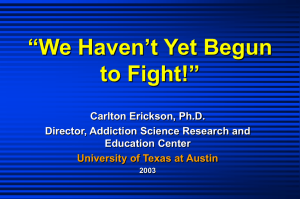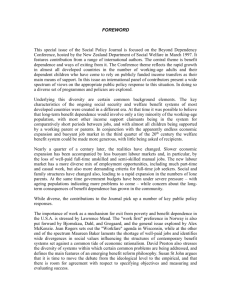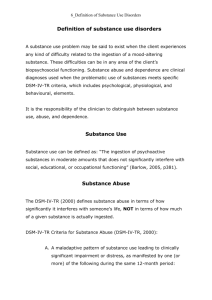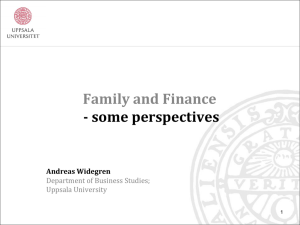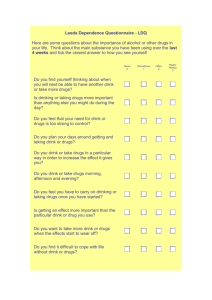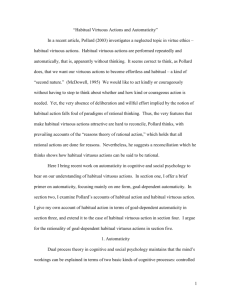Notes on The Potent Self
advertisement
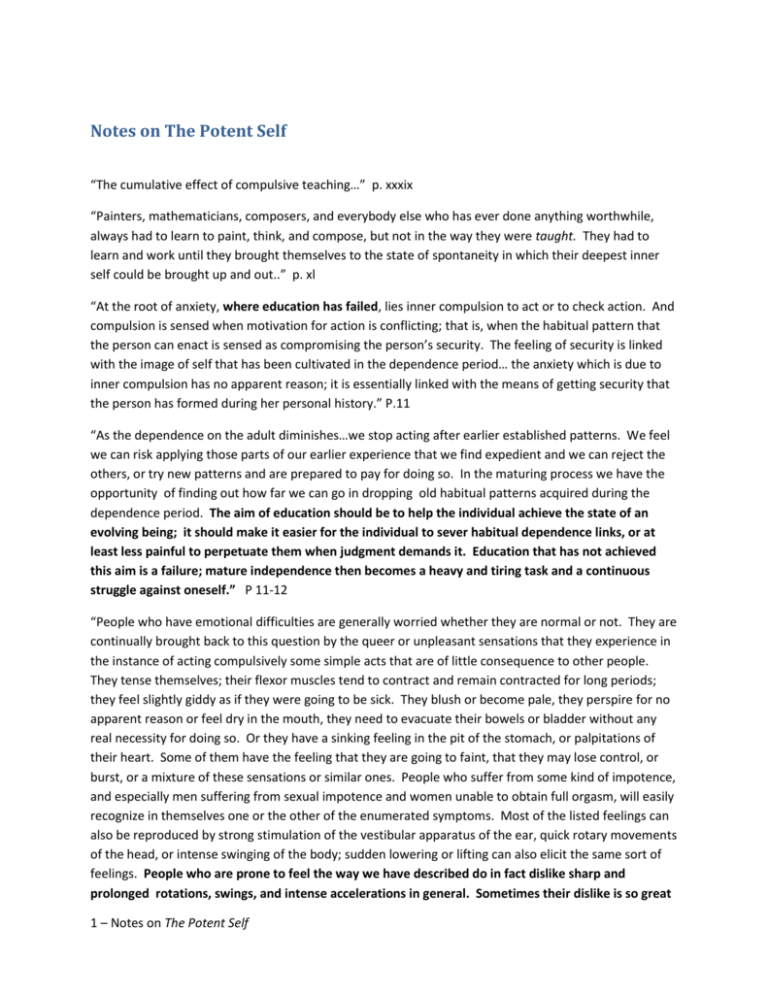
Notes on The Potent Self “The cumulative effect of compulsive teaching…” p. xxxix “Painters, mathematicians, composers, and everybody else who has ever done anything worthwhile, always had to learn to paint, think, and compose, but not in the way they were taught. They had to learn and work until they brought themselves to the state of spontaneity in which their deepest inner self could be brought up and out..” p. xl “At the root of anxiety, where education has failed, lies inner compulsion to act or to check action. And compulsion is sensed when motivation for action is conflicting; that is, when the habitual pattern that the person can enact is sensed as compromising the person’s security. The feeling of security is linked with the image of self that has been cultivated in the dependence period… the anxiety which is due to inner compulsion has no apparent reason; it is essentially linked with the means of getting security that the person has formed during her personal history.” P.11 “As the dependence on the adult diminishes…we stop acting after earlier established patterns. We feel we can risk applying those parts of our earlier experience that we find expedient and we can reject the others, or try new patterns and are prepared to pay for doing so. In the maturing process we have the opportunity of finding out how far we can go in dropping old habitual patterns acquired during the dependence period. The aim of education should be to help the individual achieve the state of an evolving being; it should make it easier for the individual to sever habitual dependence links, or at least less painful to perpetuate them when judgment demands it. Education that has not achieved this aim is a failure; mature independence then becomes a heavy and tiring task and a continuous struggle against oneself.” P 11-12 “People who have emotional difficulties are generally worried whether they are normal or not. They are continually brought back to this question by the queer or unpleasant sensations that they experience in the instance of acting compulsively some simple acts that are of little consequence to other people. They tense themselves; their flexor muscles tend to contract and remain contracted for long periods; they feel slightly giddy as if they were going to be sick. They blush or become pale, they perspire for no apparent reason or feel dry in the mouth, they need to evacuate their bowels or bladder without any real necessity for doing so. Or they have a sinking feeling in the pit of the stomach, or palpitations of their heart. Some of them have the feeling that they are going to faint, that they may lose control, or burst, or a mixture of these sensations or similar ones. People who suffer from some kind of impotence, and especially men suffering from sexual impotence and women unable to obtain full orgasm, will easily recognize in themselves one or the other of the enumerated symptoms. Most of the listed feelings can also be reproduced by strong stimulation of the vestibular apparatus of the ear, quick rotary movements of the head, or intense swinging of the body; sudden lowering or lifting can also elicit the same sort of feelings. People who are prone to feel the way we have described do in fact dislike sharp and prolonged rotations, swings, and intense accelerations in general. Sometimes their dislike is so great 1 – Notes on The Potent Self that they avoid such movements even in their daily behavior, in their gait, and in turning or bending. The highly strung person is recognized by the muscular readiness to stiffen in order to prevent any movement that may produce these unpleasant sensations. She must be ready to check and control her body lest it become involved in the sudden, uncontrollable motion that she dreads.” P. 12 <Dalcroze addressed these problems, whether he recognized it or not, by coordinating such movements with music, making them intentional and placing them in a non-compulsive context.> “As the dependence on the adult diminishes, “Until very recently, education was so dogmatic, and people were so sure of what was good for others, and the ultimate object of life was so obvious to them that they did not hesitate to use the dependence factor to exclude most personal spontaneous tendencies.” p. 43 “The complex structure of human behavior and its dependence on the environment must not be overemphasized; otherwise, the integrative capacity of our nervous system is barely recognizable and often completely ignored, as if it played no role in the direction of ourselves. We are often presented as mere playgrounds for the body tensions, environment and circumstances. Indeed, this picture is often correct, since the normal ways of “education” arrest development in most planes of emotional motivation except those few that are sustained by our ways of life, so that we make the mistake of taking the past and present as the norm of human possibility.” p.60 “The shortcomings of many educators and methods are largely due to neglecting to recognize the process of maturing in its entirety. Often, therefore, remedial action is directed to the act, and not to the way it is performed. The maladjustment expresses itself not in the act or object of the act, but in the internal attitude that it brings about.” p. 102 “More is learned in this lesson than is immediately apparent. Control of mental direction is improving, and one learns the importance of clear thinking, while allowing the projected action to be enacted. The learning is done in one’s own body language; weeks of verbal interchange may not achieve so intimate a recognition of the fact that the inability to do is due to the voluntary projection of parasitic habitual patterns, of which one can become aware when the level of excitation is reduced. When the tension present is small, the kinesthetic sense is refined and becomes capable of detecting smaller and smaller differences. But perhaps the most interesting feature of this lesson is that one discovers that one’s own resources are not fully used, but are actively prevented from being used.” P. 159 “To bring a person to realize emotionally that what happens to him is the result of his misuse of himself, that he uses an infantile emotional pattern without awareness, one has to break through his resistance to the analyst by giving timely interpretations of his behaviors and attitudes. Here the breaking of the resistance is done directly, in the most intimately understood body language; the person is not asked to give up the old pattern, which he cannot do, before he has another substitute. By enlarging his range of ability, he gains freedom of choice, and the compulsiveness attached to a unique alternative is lifted. The ability to do so abrogates the old, impotent acture by the same mechanism with which we reject all that does not open the door and choose the one that does. One is not reluctant to give 2 – Notes on The Potent Self up action that does not work properly when in possession of a correct method that does so; one even feels somewhat foolish for not having thought of it before.” P. 159 “The interpersonally trifling importance of the action of flexing the body (for indeed, what does it matter whether one’s body is flexible or not) has, nevertheless, a much deeper personal significance. The importance of any act is derived from its social value, but from the point of view of internal functioning the exclusion of physiological action to the point of inability to use it is of immense importance. “ p. 159 “Thus an experienced teacher can detect a great variety of extraneous motivations that interfere with the accomplishment of complete flexion even in these first static states of acture…With experience, the teacher is able to detect the part of the body that is in the person’s mental self-image, more or less permanently, and produces parasitic contractions in every action. / However, it does no good to mention these findings; to do so would be only to provoke a flood of rationalizations, which are necessary to sustain the personal acture; they constitute what analysts call resistance. Our way is to first give the student the means to act without bringing into action his habitual self-mobilization.../ Resistance is resolved through becoming unnecessary.” P. 160 “The next step after having explored a fuller range of function (in this case, the flexion of the spine) is to learn reversibility…/ The learning consists in acquiring the ability of projecting the movement and following it through in space, projecting the kinesthetic sensations before the act, and then enacting the mental body image of the sensation in actual performance.” P. 161 “The mature person does things for the sake of doing them or because they are expedient, and not for the sake of approval by seniors, equals or subordinates.” P. 230 (In relation to doing things to “please” a teacher, and, conversely, teaching to “impress” or gain reverence from a student.) “Even in the need for approval you must achieve reversibility and learn to care for approval but without compulsion…Extraneous motivations of social, moral and self-assertive origin cannot be entirely eliminated in our society, and we are bound to enact some of them by habit. We must, however, not allow them to become dominant, in which case we feel powerless. ” P. 231-2 (This is in a discussion of the sexual act, but can apply to teaching in general.) 3 – Notes on The Potent Self



